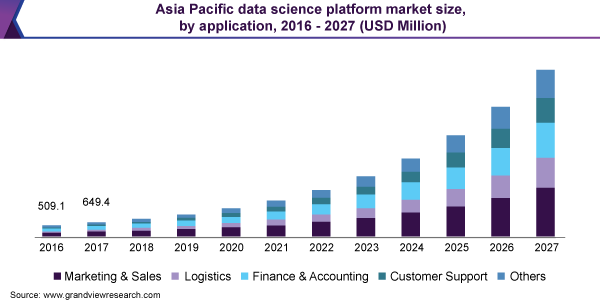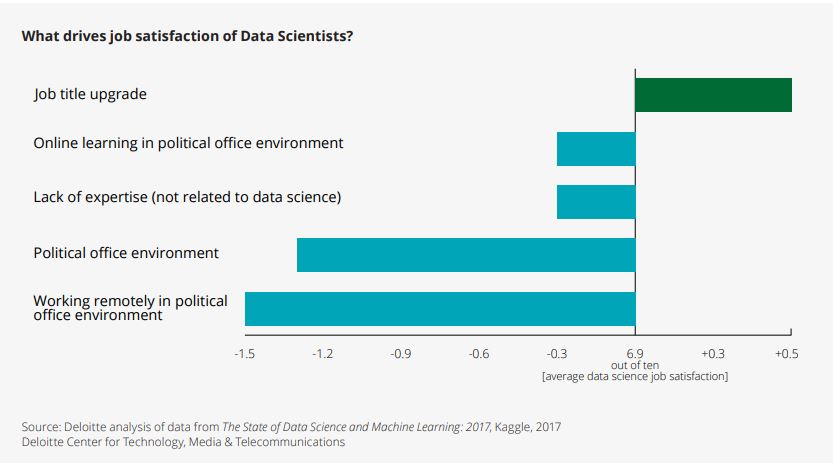Data science has revolutionized the world of business in the past few years.
More companies are employing data scientists and making data-driven decisions than ever before. There is a growing demand for experts who can interpret and develop conclusions from the vast amounts of data generated daily. Still, many enterprises find it challenging to attract and retain top data science candidates.
Consequently, data science has become one of the fastest-growing fields over the last decade.
A report by Grand View Research pointed out that the market size of data science was valued at 3.93 billion USD in 2019. This market size is projected to grow at a compound annual growth rate (CAGR) of 26.9% from 2020 to 2027, to reach 25.9 billion by 2027. The diagram below shows the year-on-year growth of the global data science market.

Source: Grand View Research
On the flip side, many talented data professionals are unable to land a good data science job because of faulty recruitment processes and unskilled hiring managers. As a result, it leads to a mismatch between a recruiter’s requirements and an aspirant looking for a decent job in the field of data science.
How To Attract Top Data Science Candidates
As mentioned earlier, data science is snowballing, and multiple industries are eyeing the most talented data scientists.
According to the Bureau of Labor Statistics, Computer Systems Design and Related Services, and Management of Companies and Enterprises, are the two sectors hiring the most data science candidates. The bureau also reports that Computer and Peripheral Equipment Manufacturing and Semiconductor & Other Electronic Component Manufacturing pay the highest salaries to data scientists.
The former gives data scientists an average annual salary of USD 148,290, while the latter provides USD 142,150. In addition, the mean hourly wage for data scientists in these two sectors is $ 71.29 and $ 68.34, respectively. Despite these high salaries, companies are struggling to attract top data science candidates for many reasons.
Brandon Purcell, vice president, and principal analyst at Forrester, a research and advisory firm from Cambridge, says, “Companies are struggling to hire true data scientists. It’s very, very challenging, especially if [the companies aren’t the biggest brands and the biggest names. Data scientists have the alchemy to turn data into insights. … There’s a lot of thought going into how to hire and retain them.“
Here are the best practices for corporations looking to hire the most talented data scientists globally:
1) Refine Your Recruitment Process
The recruitment process of data scientists is outdated in many corporations. Data science is a highly technical field that requires a solid recruitment process focusing on the skillset of candidates. Several organizations still opt for a generalist approach when hiring data scientists, which can often backfire and lead to candidates looking for greener pastures.
Moreover, companies appoint hiring managers who are not well versed in the concepts of data science and related fields. As a result, these recruiters often overlook a talented data science candidate due to insufficient domain knowledge.
Businesses looking for data scientists should revamp their recruitment process to better suit the needs of aspiring candidates. They should appoint hiring managers who have a basic understanding of technical concepts while communicating effectively with the applicants.
2) Write Short Job Descriptions
A typical data science candidate applies for several jobs when they’re looking for a good data science job. As a result, most data science candidates have a brief look at each position and generally skim through the job descriptions. Long, monotonous job descriptions often seem like a huge stumbling block and unappealing to these aspirants.
Hiring managers and recruiters should create short job descriptions and be to the point. These job descriptions should convey exactly what the company is looking for and briefly mention the roles and responsibilities of the candidate.
The Muse estimates that job descriptions for jobs in finance and data have an average of about 450 words. Meanwhile, Undercover Recruiter advises that your job description should be between 500 and 600 words. Because of this, keeping a data scientist job description concise is a good idea.
Furthermore, companies should avoid using technical jargon and confusing phrases in data scientist job descriptions as it can throw away potential candidates. A simple, concise, and direct job description is the best way to go when your goal is to attract the best data science candidates.
3) Use Structured Interviews
Most data science candidates decide to move away from a potential employer in the interview stage. Naturally, companies need to reform their interview process and use structured interviews wherever possible.
The use of a set of uniform questions is a key component of structured interviews. In contrast to unstructured interviews, where the interviewer does not prepare a list of pre-planned interview questions, these questions are typically written before the interview starts.
A structured interview process can help you stay objective, use a legally defensible approach while hiring, and improve the candidate experience. Asking closed-ended questions will help you conduct a structured interview, limit the possible responses from your data scientist prospects, and make it easier to compare and evaluate their responses.
4) Provide Better Benefits
Most companies provide typical additional benefits like health insurance, bonuses, and others, along with the basic salary. The statistics above show that corporations pay top dollar for the most talented data scientists. However, they need to provide something extraordinary to attract the best data science candidates to their organization.
Organizations that put an emphasis on their workers’ mental, physical, and emotional health have an advantage over rivals in the marketplace. Companies should think about designating days off for everyone to unwind and recover, for instance, as burnout is becoming a widespread concern across industries.
Furthermore, the Covid-19 pandemic has fostered the remote working environment in numerous companies, allowing data scientists to be at their most creative at a time and place of their choosing. Some corporations have instituted a hybrid model, while others have started following four working days a week.
Meanwhile, some organizations provide an “Open-source Day” where data scientists and engineers can work on open-source projects they want to support. Such initiatives will go a long way to attract the best data science candidates to your firm.
Why Data Scientists Leave An Organization
Data scientists and engineers are among the highest-paid employees, and many companies are also providing unique benefits such as the ones mentioned above. Still, data scientists have a high turnover rate than many other sectors.
A report by Kaggle suggests large companies are losing data scientists at a rate of more than 20%. The below infographic shows data science candidates migrating to small companies from big multinational firms.

Source: Towards Data Science
Companies with more than 250 employees saw a decrease of more than 20%, while larger firms with more than 10,000 workers witnessed a similar turnover of data science professionals. This dramatic shift could be a consequence of small companies fostering creativity and innovation, while bigger corporations have rigid schedules and reduced autonomy.
Firms must rethink their policies and work culture if they want to attract and retain the best data science professionals. Here are some of the most common reasons why data scientists quit their jobs.
-
Lack of Autonomy
Data science is a technical discipline, but it also requires a creative mindset from professionals. Most data scientists thrive in such conditions where they are free to explore the limits of technology. However, companies often fail to provide a liberal work environment to data science professionals where they are constantly monitoring their activities.
Moreover, these data scientists aren’t allowed to work on open-source projects that aren’t directly related to their companies. Hence, they often end up leaving the organization for a place that promotes creativity and innovation, sometimes even taking a pay cut.
-
Lack of Exposure To New Technologies
Data science is a continuously evolving field, and candidates want to work in a corporation that is willing and able to invest in the most technologically advanced resources. A study by Deloitte confirms this statement where respondents said they planned to pick up new skills “on the job” through new tools and methods. Comparing businesses with and without internal learning platforms, the former predictably boosts job satisfaction by 0.3 points.

Source: Deloitte
-
Delayed or Abandoned Projects
Venture Beat reports that more than 85 % of data science projects never make it to production. This news is heartbreaking to data scientists and engineers who spend countless hours on a given project. Companies usually cancel these projects as they’re not financially viable and do not help in direct profit generation for the firm.
The model-to-market process can occasionally be excruciatingly slow, even after models are put into production. The delight data scientists get when they see their models in action can be increased by looking into where and why projects are delayed and then putting strategies in place to address problems and speed up procedures.
How to Retain the Best Data Science Candidates
By now, you should have a rough idea of attracting data scientists and why they keep leaving their jobs despite good pay and benefits. Fostering innovation and giving autonomy are the two most important ways to retain data science candidates. Here are other techniques you can use to attract and retain the best data scientists.
1) Provide Ample Growth Opportunities
Like other professions, data scientists prefer working in an organization that promises growth and provides clarity on their career trajectory. This necessitates a commitment from companies to foster their staff members’ professional development and be open about any prospective career options within the business.
Leaders should design distinct career paths for managers and individual contributors so that everyone can see the actions needed to accomplish their objectives. Organizations will be able to accept the greatest data professionals worldwide while embracing a culture of trust and transparency if career trajectories are communicated from the beginning.
2) Provide Competitive Compensation
Make sure your pay is comparable to or higher than that offered by other businesses of your size and your rivals. Additionally, ensure your offer package contains attractive benefits like the ability to work remotely and flexible hours. These days, compensation not only includes the basic salary but extra perks like bonus pay and other benefits like insurance and paid holidays.
3) Promote Creativity and Invention
Data scientists are in high demand and desire to work on the most crucial projects for the business. They frequently feel underutilized if they are required to spend their time performing monotonous chores like data acquisition and data maintenance. Giving data scientists futuristic projects to work on allows them to come up with new ideas for how the business can use big data.
Closing Words
Attracting and retaining data scientists is not so difficult when companies understand what data science candidates are seeking. By following the methods mentioned above, corporations can attract the best data scientists in the world and retain them for years to come.
Keep in mind that hiring requires more than just attracting and hiring people; it’s a commitment. Contact us at BenchPoint, a healthtech recruitment agency, to find out more about how you can locate the most extraordinary data science talent in a significantly shorter amount of time.
